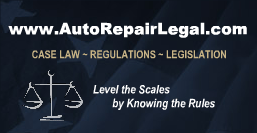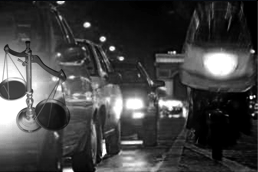

|
||||||||||||
|
|
|
|
|
|
Sale of Vehicle Without Disclosure of Prior Damage - Consumer Fraud - 10/7/1991
Knapp v. Potamkin Motors Corp., 602 A.2d 302, 253 N.J.Super. 502 (N.J.Super.Law
Div. 10/07/1991)
[1] New Jersey Superior Court, Law Division
[2] No. W-023871-89
[3] 602 A.2d 302, 253 N.J.Super. 502, 1991.NJ.40291
[4] Decided: October 7, 1991.
[5] MICHAEL W. KNAPP, PLAINTIFF,
v.
POTAMKIN MOTORS CORP., DEFENDANT
[6] SOMERSET COUNTY
[7] William J. Schwartz, for plaintiff.
[8] Howard A. Teichman, for defendant.
[9] Arnold, P.J.Cv.
[10] Arnold
[11] ARNOLD, P.J.Cv.
[12] This is a consumer fraud action based on an allegation that
defendant knowingly concealed, suppressed or omitted a material fact with
the intent that plaintiff rely on the concealment, suppression or
omission. This court instructed the jury that in order to find that
defendant committed a consumer fraud "it is not necessary for the
plaintiff to prove that he was misled." That language appears in the
"Second Alternate" portion of model jury charge (civil) § 4.22 (April
1987). The jury decided that defendant committed a consumer fraud, and
awarded plaintiff $5,000 in damages. Defendant moves for a judgment n.o.v.
or in the alternative for a new trial or remittitur. Based on a review of
the history of the Consumer Fraud Act and the relevant case law, this
court holds that the jury should not have been instructed that "it is not
necessary for the plaintiff to prove that he was misled" and that the
instructions were so contradictory as to constitute reversible error
requiring a new trial.
[13] The material facts are as follows. On September 30, 1987,
plaintiff, Michael Knapp, bought a "new" Chevrolet S-40 Blazer truck from
defendant, Potamkin Motors Corp. (Potamkin). Plaintiff accepted delivery
after dark and he noticed no damage to the truck. However, about a week
later, after his wife discovered pieces of glass behind the front seat,
plaintiff examined the truck and found places where paint had been sprayed
on parts not normally painted. He brought the truck to an expert in the
auto body repair business who told him that the roof and other areas had
been damaged and improperly repaired. Plaintiff sued Potamkin alleging,
inter alia, that Potamkin violated the Consumer Fraud Act by selling him
as "new" a truck that had been substantially damaged prior to delivery. At
trial, the expert testified that the repairs had not been properly made,
that at the time of his inspection it would have cost $2,000 to properly
repair the truck, and that it would now cost in excess of $4,000 to
properly repair the truck. Potamkin's representative in his testimony
admitted that the truck had been damaged in transit from the factory, and
that this had not been disclosed to plaintiff. He testified that no
disclosure was made because the cost of the repairs was less than $400 and
Potamkin had a policy of not disclosing to a customer that a vehicle being
sold as "new" had sustained damage unless the cost of repair exceeded
$400. Potamkin argued that the car had been properly repaired.
[14] As originally enacted in 1960, the Consumer Fraud Act, N.J.S.A.
56:8-1 et seq., did not provide a private cause of action. In section 2,
it declared certain practices to be unlawful "whether or not any person
has in fact been misled, deceived or damaged thereby" and gave the
Attorney General certain powers to redress violations. N.J.S.A. 56:8-3 et
seq. In 1971, the act was substantially amended and section 19 was added.
That section allows a private cause of action by a person who has been
damaged as a proximate result of a violation of the act. Specifically
section 19 reads in relevant part:
[15] Any person who suffers any ascertainable loss of moneys or
property, real or personal, as a result of the use or employment by
another person of any method, act, or practice declared unlawful under
this act or the act hereby amended and supplemented may bring an action or
assert a counterclaim therefor in any court of competent jurisdiction . .
. .
[16] The legislative history of the 1971 amendment is very meager and
is set forth in Skeer v. EMK Motors, Inc., 187 N.J. Super. 465, 471-472,
455 A.2d 508 (App.Div.1982). In Skeer the court concluded that the 1971
amendment was intended to encourage private parties to bring their own
actions instead of the Attorney General and to provide an incentive for an
attorney to take a case by mandating payment of attorneys fees and treble
damages. But, there is no legislative history to indicate whether the
Legislature considered the relationship between the language in section 2,
declaring certain practices to be unlawful "whether or not any person has
in fact been misled, deceived or damaged thereby," and the requirement in
section 19 requiring a person to show damages as a proximate result of a
violation of the Consumer Fraud Act in order to recover.
[17] This court agrees with defendant that the only logical
interpretation of sections 2 and 19 is that the Attorney General has the
authority to seek to redress and enjoin violations of the act whether or
not any person has been misled, damaged or deceived thereby, but that a
private person must be misled and damaged as a proximate result of a
violation of the act in order to have standing to sue. This court's
reasoning is as follows.
[18] There are two categories of offenses in the Consumer Fraud Act.
Chattin v. Cape May Greene, Inc., 124 N.J. 520, 522, 591 A.2d 943 (1991)
(Stein, J., concurring). The first category of offenses -- unconscionable
commercial practices, deception, fraud, false pretenses, false promise and
misrepresentation -- are affirmative acts. They do not require proof of
intent to deceive. Ibid. The second category differs from the first
because they are acts of omission and they do require proof of intent to
deceive.*fn1 This distinction is similar to the distinction between
equitable fraud and legal fraud. Ibid.; see also Jewish Center of Sussex
County v. Whale, 86 N.J. 619, 624-625, 432 A.2d 521 (1981). Like the first
category, equitable fraud does not require proof of intent to deceive.
However, legal fraud is similar to the second category because scienter
and proof of damage proximately caused by the act are required.
[19] The elements of legal law fraud are: (1) material
misrepresentation of a presently existing or past fact, (2) knowledge of
its falsity and an intention to obtain an undue advantage and (3) the
intention that the other party rely thereon, resulting in reliance by the
other party to his detriment. Jewish Center of Sussex County v. Whale,
supra. These elements of proof are set forth in the third paragraph of the
"Second Alternate" portion of model jury charge 4.22. But the second
paragraph of that charge recites that "it is not necessary that any person
has in fact been misled or deceived." This charge is correct in an action
brought by the Attorney General since section 2 of the act specifically
provides that such proof is not necessary. However, this charge is
inconsistent and confusing when a private party brings an action since
that party must prove the elements of legal fraud as well as damages under
section 19. See Mishinsky v. Nichols Yacht Sales, Inc., 110 N.J. 464, 473,
541 A.2d 1063 (1988).
[20] The verb mislead means to lead in a wrong direction, to deceive.
Webster's Third New International Dictionary (1981) at 1444. To instruct
the jury that plaintiff had to prove all of the elements of legal fraud,
including damages, while also instructing them that plaintiff did not have
to prove that he was misled, is to give the jury contrary instructions.
These instructions were so contrary as to constitute error and require a
new trial. Davidson v. Fornicola, 38 N.J. Super. 365, 118 A.2d 838
(App.Div.1955).
[21] Accordingly, defendant's motion for a new trial is granted. At the
new trial this court will not instruct the jury that "it is not necessary
for plaintiff to prove that he was misled."
Opinion Footnotes
[22] *fn1 Specifically, they require the knowing concealment,
suppression, or omission of any material fact with the intent that others
rely on such concealment, suppression or omission. Fenwick v. Kay American
Jeep, Inc., 72 N.J. 372, 377, 371 A.2d 13 (1977).
